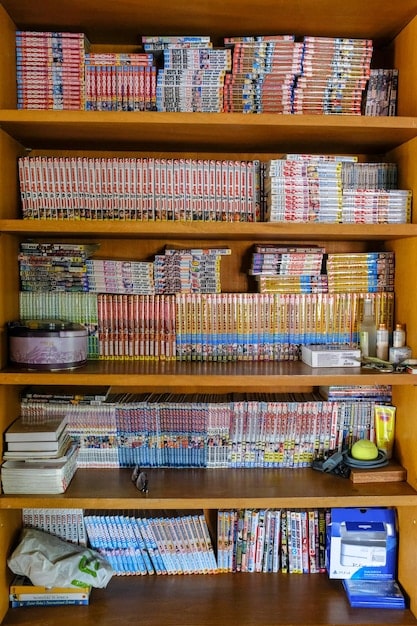Manga Release Checklist: Essential Steps After Buying Shonen Manga

A Manga Release Checklist: Essential Steps to Take After Buying a New Shonen Manga Volume ensures your prized collection remains in top condition, from initial inspection for damages to proper storage and cataloging, guaranteeing a lasting enjoyment of your favorite series.
So, you’ve just snagged the latest volume of your favorite shonen manga. Excitement is in the air, but before you dive into the action-packed panels, take a moment. Is there a manga release checklist: essential steps to take after buying a new shonen manga volume to ensure it is in new condition? Lets find out.
Unboxing and Initial Inspection
The thrill of acquiring a new manga volume is undeniable. However, before diving headfirst into the story, a crucial step is to unbox and carefully inspect your new treasure. This process ensures you’ve received the manga in pristine condition and allows you to address any potential issues promptly.
Carefully Remove the Packaging
Resist the urge to rip open the packaging in your excitement. Instead, use scissors or a knife to gently slice through the wrapping. This prevents accidental damage to the cover and edges of your new manga.
Check for Obvious Damage
Once unwrapped, examine the manga for any visible damage. Look for:
- Bent Corners: Gently run your fingers along the corners to feel for any creases or folds.
- Tears or Rips: Inspect the cover and pages for any tears, especially along the spine and edges.
- Water Damage: Check for discoloration, warping, or a musty odor, which could indicate water damage.
- Printing Errors: Quickly flip through the pages to spot any major printing errors, like missing pages or blurry panels.
Taking the time for this initial inspection safeguards your investment and allows you to take action.

In summary, the first step from a manga release checklist starts with a careful, mindful unboxing and a meticulous survey for damages.
Cataloging Your New Volume
Now that you’ve confirmed your new manga is in good condition, it’s to integrate it seamlessly into your existing collection. Cataloging might seem tedious, but it offers important benefits for any serious manga collector.
Update Your Inventory
Whether you use a spreadsheet, a dedicated app, or a simple notebook, keeping an updated inventory of your manga collection is essential. Include details like:
- Series Title: The full name of the manga series.
- Volume Number: The specific volume number you’ve just acquired.
- Publisher: The company that published the manga (e.g., Viz Media, Dark Horse Comics).
- Purchase Date: The date you bought the manga.
Consider Using a Manga Management App
Several manga management apps are available for iOS and Android. These apps often allow you to scan the barcode of your new manga to automatically add it to your collection.
By maintaining a meticulous record of your manga acquisitions, you will save time when searching for a story or organizing your collection in order.
Proper Storage Techniques
How you store your manga can significantly impact its longevity. Improper storage can lead to warping, yellowing, and other forms of damage. Following these guidelines helps keep your collection in top condition.
Avoid Direct Sunlight
Sunlight is one of the biggest enemies of manga. UV rays can fade the colors on the cover and cause the pages to yellow over time. Store your manga away from direct sunlight to prevent this.
Control Humidity Levels
High humidity can cause manga to warp and develop mold. Keep your manga in a cool, dry place with relatively stable humidity levels. Consider using a dehumidifier in areas with high humidity.
Use Shelving or Boxes
Store your manga on shelves or in boxes to prevent them from being crushed or bent. Ensure the shelves are sturdy enough to support the weight of your collection. Acid-free boxes are a good option for long-term storage.
The act of storing manga to avoid sunlight, humidity and stacking correctly so that they don’t become crushed are essential when trying to maintain a great collection.

Handling with Care
Even with proper storage, how you handle your manga plays a crucial role in preserving its condition. Avoid these common mistakes to keep it in tip-top shape.
Handle with Clean Hands
Always wash your hands before handling your manga. Dirt, oil, and other contaminants on your hands can transfer to the pages and cause discoloration or staining.
Avoid Eating or Drinking While Reading
Spills and crumbs can easily damage your manga. Keep food and drinks away from your collection to prevent accidents.
In short, being careful with the environment around your manga and being neat handed are important when reading.
Reading and Preservation Tips
Now that your manga is safely stored and you’re ready to read, consider these tips to further protect it during reading sessions.
Use Bookmarks
Avoid folding the corners of pages to mark your place. Use a bookmark instead. A simple piece of paper or a decorative bookmark will do the trick.
Avoid Bending the Spine Excessively
While reading, avoid bending the spine of the manga too far back. This can weaken the binding and cause the pages to loosen over time.
Read on a Clean Surface
Place your manga on a clean, flat surface while reading. This will prevent it from getting dirty or damaged by rough surfaces.
When reading, consider finding a bookmark instead of bending the pages and laying them on smooth surfaces, to maintain shape.
Dealing with Minor Imperfections
Despite your best efforts, minor imperfections may still appear on your manga over time. Here’s how to address some common issues.
Removing Minor Smudges
For minor smudges on the cover, gently wipe with a soft, dry cloth. Avoid using any liquids or harsh chemicals, which can damage the surface.
Flattening Bent Corners
To flatten bent corners, carefully press them between two heavy books for a few days. This can help restore the original shape of the corner.
If you are able to remove smudges or slightly bent corners right away, it’s easier maintenance so that your manga is at its best possible quality.
Knowing When to Seek Professional Help
For more serious damage, such as significant tears or water damage, consider seeking professional help from a bookbinder or conservator. They can make repairs that will help preserve your manga.
- They can make repairs that will help preserve your manga.
- When a manga has been soaked with water or has had extensive damage, only professionals will be able to salvage.
Ensuring Long-Term Enjoyment
By following this manga release checklist: essential steps to take after buying a new shonen manga volume, you’re not just preserving a physical object – you’re safeguarding a piece of art and a source of endless enjoyment. Treat your manga with the care it deserves, and it will continue to bring you joy for years to come.
In conclusion, following the steps as a manga owner will ensure that your collection maintains value in the long run.
| Key Step | Brief Description |
|---|---|
| 📦 Initial Inspection | Check for damage upon unboxing. |
| 📚 Cataloging Volume | Update inventory with new acquisitions. |
| ☀️ Storage Tactics | Avoid sunlight and control humidity. |
| 🤝 Handling | Use clean hands, avoid eating/drinking. |
FAQ
▼
Initial inspection helps ensure you receive your manga in perfect condition and identify any damages early. Addressing issues promptly can prevent them from worsening.
▼
Store your manga away from direct sunlight, in a cool, dark place. UV rays can fade the colors on the cover and cause yellowing over time, reducing the manga’s aesthetic appeal and value.
▼
Shelves or boxes are ideal. Shelves keep them upright and visible, while acid-free boxes offer long-term protection from light and other environmental factors. Ensure the area is dry.
▼
Clean your manga collection every few months. Gently wipe the covers with a soft, dry cloth to remove dust and smudges. Avoid using liquids, as they can cause damage and warping.
▼
For serious damage like significant tears, water damage, or mold, consider consulting a bookbinder or conservator. They have specialized skills to address such issues properly and safely.
Conclusion
Following this manga release checklist and the advice provided will ensure your collection remains in pristine condition, allowing you to enjoy your favorite shonen manga for years to come. Remember, proper care is key to preserving not just the physical condition of the manga, but also its value and the joy it brings.





